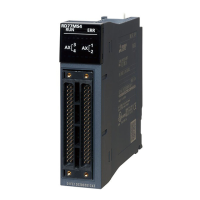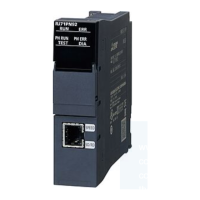9 COMMON FUNCTIONS
9.1 Outline of Common Functions
303
9
9 COMMON FUNCTIONS
The details and usage of the "common functions" executed according to the user's requirements are explained in this chapter.
Common functions include functions required when using the Simple Motion module, such as parameter initialization and
execution data backup.
Read the setting and execution procedures for each common function indicated in this chapter thoroughly, and execute the
appropriate function where required.
9.1 Outline of Common Functions
"Common functions" are executed according to the user's requirements, regardless of the control method, etc.
These common functions are executed by an engineering tool or programs.
The following table shows the functions included in the "common functions".
Common function Details Means
Program Engineering
tool
Parameter initialization function This function returns the setting data stored in the buffer memory/internal memory
and flash ROM/internal memory (nonvolatile) of Simple Motion module to the default
values.
Execution data backup function This function writes the "execution data", currently being used for control, to the flash
ROM/internal memory (nonvolatile).
External input signal select
function
This function sets the input type, input terminal, signal logic and input filter for each
external input signal of each axis (upper/lower stroke limit signal (FLS/RLS), near-
point dog signal (DOG), and stop signal (STOP)).
The function enables the assignment of external input signal of each axis to any
terminals of 20 points of the external input connection connector on the Simple
Motion module.
History monitor function This function monitors start history and current value history of all axes.
Amplifier-less operation function This function executes the positioning control of Simple Motion module without
connecting to the servo amplifiers. It is used to debug the program at the start-up of
the device or simulate the positioning operation.
Virtual servo amplifier function This function executes the operation as the axis (virtual servo amplifier axis) that
operates only command (instruction) virtually without servo amplifiers.
Driver communication function This function uses the "Master-slave operation function" of servo amplifier. The
Simple Motion module controls the master axis and the slave axis is controlled by
data communication between servo amplifiers (driver communication) without Simple
Motion module.
Mark detection function This function is used to latch any data at the input timing of the mark detection signal
(DI).
Optional data monitor function This function is used to store the data selected by user up to 4 data per axis to buffer
memory and monitor them.
Event history function This function collects errors and event information occurred in the Simple Motion
module in the CPU module, and saves them to an SD memory card.
This function enables to check the error history even after the power OFF or reset by
holding the error contents in the CPU module.
Connect/disconnect function of
SSCNET communication
Temporarily connect/disconnect of SSCNET communication is executed during
system's power supply ON. This function is used to exchange the servo amplifiers or
SSCNET cables.
Online module change Allows to replace a module without stopping the system. For procedures for the online module change, refer to the
following.
MELSEC iQ-R Online Module Change Manual
Hot line forced stop function This function is used to execute deceleration stop safety for other axes when the
servo alarm occurs in the servo amplifier MR-JE-B.

